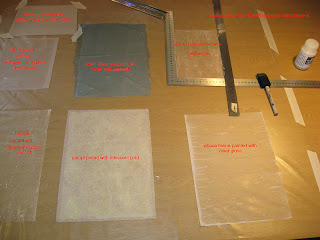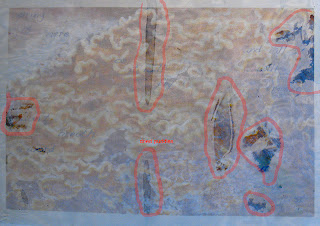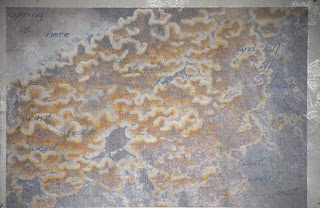For those who are not familiar with IA as I wasn’t, till Shirley introduced me to it, it’s a series of different mediums that you can paint on to anything you can safely feed through your printer.
First of all I took 7 different surfaces to paint the different solutions on to.
Japanese Sanwa tissue, painted with semi clear gloss
Gampi tissue, painted with iridescent gold
Albaca tissue, painted with clear gloss
Silk organza, painted with precoat type II semi gloss
Nylon sheer, painted with white matt
Lens tissue, and tracing paper painted with adhesive
Velum, painted with white matt and adhesive.
To understand the different properties and uses for each of the above samples I went to the this site and followed the instructions for each of the samples in my pack.
Using Shirley's advise, I set out a plastic sheet and painted each piece in turn with a sponge paint brush, but I think maybe a block of foam would have been easier as it makes less wrinkles, according to Shirley, I held the pieces down with metal rulers, as it would have been difficult to tape some of the finer tissues.

The first piece I printed was the lens tissue, and although I’d painted it with the adhesive which was for non porous materials as I thought it was, the printer wheels slipped over the crispy surface and left drag lines on the image, so undeterred I had another go on the abaca tissue, a much softer tissue, which with the help of the clear gloss precoat gave a similar image to the one I’d achieved before on tracing paper, but this tissue is stitchable.

The next sample I tried was the nylon sheer, which was painted with the white matte precoat as this is designed for nonporous materials. When it dried it had some large white puddle marks on it, so I can only assume that I painted the medium on too thick. But it did print, which is the first time I’ve been able to print sheers. I deliberately put a low opacity on this image as I wanted the layers beneath to show through, but if I’d printed it with a high saturation it would have printed even better, maybe 2 coats of precoat next time.

This piece does have some text on it, as I wanted to add it to the layers I was compiling for a piece, which I will publish when it’s finished.
I printed this same image onto silk organza, coated with precoat type II semi gloss which gave a much better effect.

Another part of the above piece is the starting layer that I printed onto Gampi tissue, which was coated with iridescent gold. So far this piece has been the most successful for the image that I was using, it gives a lovely pearlised finish, which just glimmers through the image.

I still have a couple of samples to try for this experiment and will document them at a later date, together with some test samples that haven’t been precoated. All the paper samples were bonded to pieces of photocopy paper with spray mount before putting through the printer, and the fabrics were ironed on to Freezer paper.
The tissues and the InkAid sample set were purchased from ArtVanGo. I also bought a very good book on the subject of Digital Printing from AVG, which again was recommended by Shirley who is a mine of information and has very generously shared her knowledge with me.

5 comments:
Thank you for sharing all this Sharon. I shall have to bookmark it to come back to later as I am interested in printing some of my own photos to fabric.
Really interesting blog Sharon. I bought some InkAid when it first came out and didn't realise it came in so many different varieties now. I like the iridescent gold sample very much.
And you are right about Shirley, very knowledgeable and very generous. :)
This is very interesting Sharon. Thanks for sharing!
All very interesting Sharon - I love it when someone else does the hard work and tells me what works best!!
great post sharon - thanks for sharing your experiments
regards
karen
Post a Comment